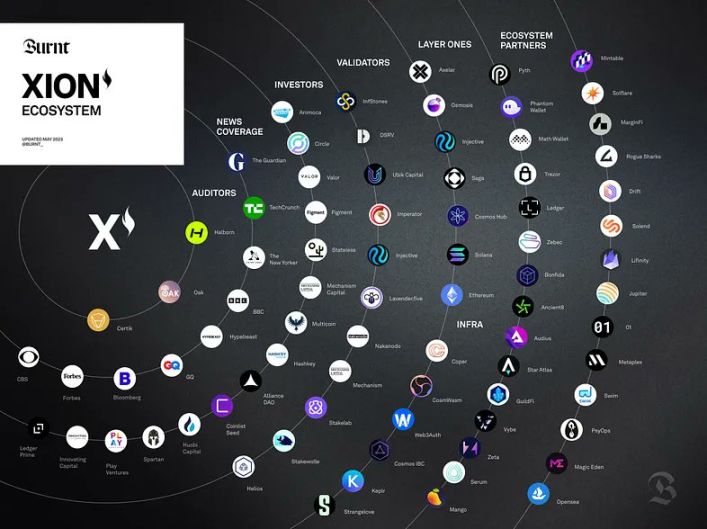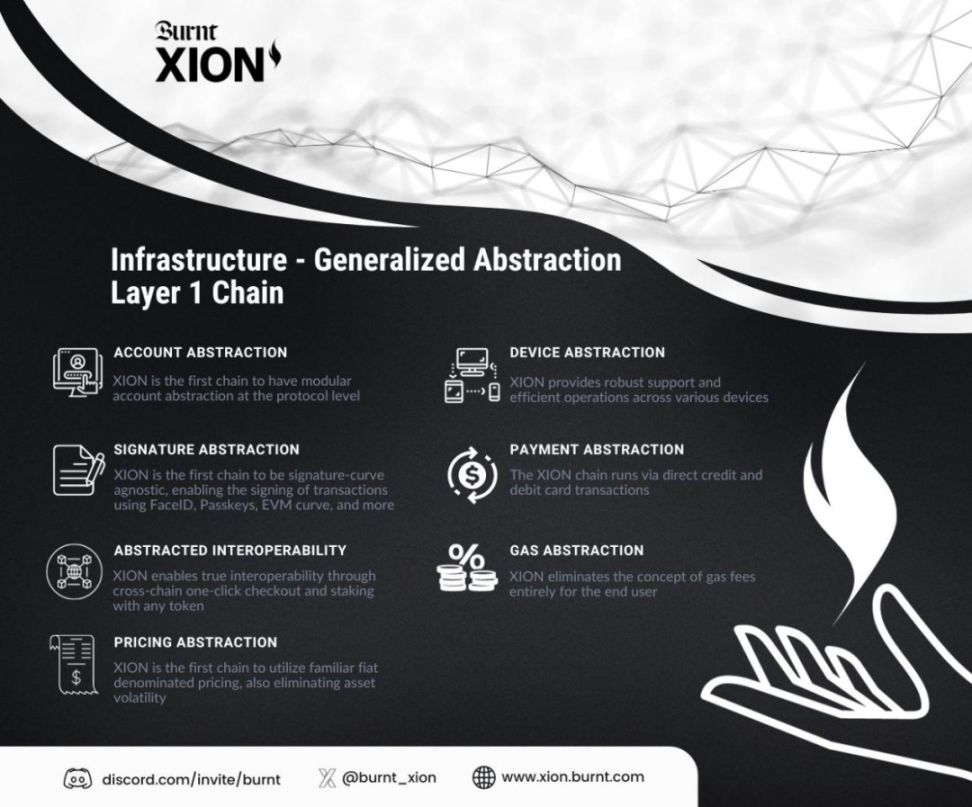A Brief Analysis of the New L1 Blockchain XION: A Catalyst for Mass Adoption of Web3?
Burnt has built the L1 blockchain XION on Cosmos, aiming to abstract away crypto complexity and overcome scalability limitations in adoption caused by cryptographic technologies.
Burnt has built the L1 blockchain XION on Cosmos, abstracting cryptographic complexity to overcome the scalability limitations in adoption caused by cryptography.
Written by: XION World
Translated by: Cullen

“If everyone is seeking the benefits of decentralized ownership, why is the Web3 industry still struggling to find the path to mass adoption?”
For years, people have discussed the potential of Web3, but in terms of user adoption, we seem to have only scratched the surface. Currently, there are two challenges to mainstream adoption of Web3—functional barriers and cultural barriers. The birth of the new L1 public chain XION aims to solve both of these problems. Let’s take a comprehensive look at XION’s vision and how it helps Web3 achieve mass adoption.
XION: An L1 Network Specializing in Abstracting Cryptographic Complexity
When talking about XION, we must mention its developer, Burnt.
Burnt’s journey in Web3 began with burning a Banksy painting. In March 2021, the Twitter account BurntBanksy live-streamed the burning of Banksy’s painting “Morons (White)” and issued it as an NFT, aiming to transfer the value of the physical artwork to the NFT. The purpose of this act was to inspire more artists to explore NFTs. Over the following year, Burnt focused on creating no-code products for creators, such as Burnt Finance and early NFT standards.

During this process, Burnt witnessed firsthand how NFTs hit a bottleneck, as the complexity of Web3 prevented large-scale adoption. “It keeps real users out while making us feel superior in a niche,” which is definitely not the end goal for Web3.
Therefore, Burnt built the L1 blockchain XION on Cosmos, abstracting cryptographic complexity to overcome the scalability limitations in adoption caused by cryptography. XION achieves a frictionless user experience while retaining Web3’s core features—decentralization, transparency, verifiable ownership, and more.
XION’s purpose is to help Web3 achieve mass adoption by addressing and optimizing both functional and cultural barriers. By focusing on user experience, accessibility, and scalability, XION aims to create an ecosystem that supports both developers and users, unlocking the full potential of blockchain technology.
Additionally, Cosmos’ Inter-Blockchain Communication (IBC) protocol allows XION, its ecosystem, and applications to quickly integrate with other application chains and their related applications. For example, if a product requires private user states, XION can connect to the Secret Network. If a product needs DeFi, XION can connect to the Injective chain and Osmosis chain. For fiat assets and non-Cosmos ecosystem assets, Cosmos also has Axelar and Noble chains. Cosmos’ “interchain” capability enables XION to immediately provide users with more features and paves the way for new use cases for developers on XION.

As for the innovations XION brings in infrastructure and functionality, perhaps we can return to the theme of this article and find answers in the question, “What barriers does Web3 face in achieving mass adoption?”
Web3 Barrier One: Complex and Unfriendly Features for Beginners
For new users interacting with Web3 applications for the first time, it may require up to 15 complex steps and several days to successfully complete an interaction. From figuring out which wallet app to download to having the necessary funds to submit a transaction, it’s no wonder the user drop-off rate is as high as 95%. With the surge of new L1 blockchains, it becomes even more overwhelming for new users. These issues have become a breeding ground for scammers who steal assets from new users, further deepening the mainstream world’s negative perception of the Web3 industry.
While user education can help make the process of first using Web3 applications more approachable, clearly, it is not a solution in itself. Just like Web2, Web3 should not require new users to understand cryptography before they can benefit from it.
How Does XION Solve These Problems?
XION can be described as an L1 built from the ground up, fully optimized for user experience.

Onboarding Doesn’t Have to Be CEX → Onchain
Currently, new users typically need more than 15 steps to purchase goods on-chain. First, they set up an on-chain wallet, then register with a centralized exchange (CEX), verify their identity, transfer funds from the CEX to the on-chain wallet, swap for the correct token on a DEX, and so on, before they can make a purchase.
However, on XION, users can use credit/debit cards to directly purchase on-chain goods, with an approval rate of over 95%, instantly covering approximately 6 billion credit/debit card holders. This not only eliminates the complex onboarding process for users but also provides a true Web2-like e-commerce purchasing experience.
No Gas Fees
Another major barrier to new user adoption is gas fees, as these force users to hold a chain’s native token in order to transact.
XION completely removes this barrier with gasless transactions, allowing new users to immediately start interacting with on-chain applications.
Abstracting Wallet Complexity
It is well known that the complexity of traditional crypto wallets leads to a drop in user adoption of over 95%. They require users to download browser plugins, go through complex setups, pop up windows for every transaction, and securely store seed phrases—such user experiences deter most non-technical/professional users.
To solve this, XION fully abstracts the entire on-chain crypto wallet experience. No plugin downloads are needed; new users can simply use their email to create an MPC wallet and seamlessly interact with applications. Crypto-native users can also use any wallet of their choice to interact with XION. XION meets the needs of all audiences.
Mobile Support
In many ways, better mobile support is also one of the paths to true mass adoption of Web3.
However, many current crypto wallets cannot freely switch between PC and mobile, require re-importing seed phrases when changing devices, and have very poor in-app browser UI/UX performance.
XION ensures mobile support through the aforementioned “abstracting wallet complexity.” In addition, it allows login and assets to be separated, creating a secure pathway for users to interact with new applications without putting their assets at risk. Essentially, it allows users to access the XION ecosystem safely, anytime and anywhere.
Pricing in USDC
It is well known that there are thousands of highly volatile cryptocurrencies in the Web3 industry, making it very confusing for new users to understand the pricing of assets/products.
With support from USDC issuer Circle, XION will become the first blockchain to use USDC as its primary transaction currency. All products built on XION will be priced in USDC, allowing new users to seamlessly use familiar fiat currency pricing formats.
Web3 Barrier Two: Not “Native,” Hard to Understand the Jargon?
In addition to functional barriers, Web3 mass adoption also faces cultural barriers.
Imagine your first encounter with crypto—does it feel like entering a new universe? It’s full of unfamiliar jargon, confusing ecosystems/applications/tokens, and complex user experiences. Moreover, the mainstream world’s perception of crypto is mired in negative news about bad actors and high-profile scams.
How Does XION Solve These Problems?
XION was designed from the outset with the core goal of abstracting cryptographic complexity.
Abstracting Jargon
To make Web3 more accessible to new users, either replace complex jargon with the most basic, easier-to-understand words, or abstract them entirely.
XION is committed to simplifying and removing technical and industry-specific terms, which is crucial for enhancing user experience and achieving broader adoption.
Enhancing Credibility
Given the mainstream world’s general skepticism toward crypto, building trust is one of the most important factors in attracting a broad audience. This is also why XION has formed strategic partnerships with many well-known companies in both Web2 and Web3. For example, well-known Web3 companies/investors like Animoca and Circle Ventures have invested in XION, and it has partnered with Web2 giants like Checkout.com, Stytch, and Stripe.
Eliminating the Need for New User Education
XION’s unique infrastructure eliminates all complexity for users, playing a key role not only in removing functional barriers but also in overcoming cultural barriers. For example, whether it’s gasless transactions, abstracted wallet complexity, or using bank cards to directly purchase on-chain goods, all greatly reduce the complexity of interactions and eliminate the traditional user education required for interacting with applications.
Conclusion
Building robust and practical infrastructure and enabling innovative users is only a small part of the challenges Web3 currently faces. To truly achieve mass adoption, we must also build the experience layer of user interaction, ensuring it is as intuitive and appealing as Web2 platforms.
XION is poised to become a catalyst for Web3 mass adoption. Its mission is not just about technological advancement—it also lays the foundation for a “Web3 cultural revolution.”
Disclaimer: The content of this article solely reflects the author's opinion and does not represent the platform in any capacity. This article is not intended to serve as a reference for making investment decisions.
You may also like
Former a16z Partner Releases Major Tech Report: How AI Is Eating the World
Former a16z partner Benedict Evans pointed out that generative AI is triggering another ten-to-fifteen-year platform migration in the tech industry, but its final form remains highly uncertain.

Which targets are Wall Street short sellers eyeing? Goldman Sachs reveals the hidden short-selling trends amid the AI wave
The most shorted stock in the United States is Bloom Energy, with other companies on the list including Strategy, CoreWeave, Coinbase, Live Nation, Robinhood, and Apollo.

Russia: Man Arrested After Attempted Bitcoin Theft Using Airsoft Grenades

QCAD Becomes Canada’s First Fully Compliant CAD Stablecoin, Eyes Wider Distribution

